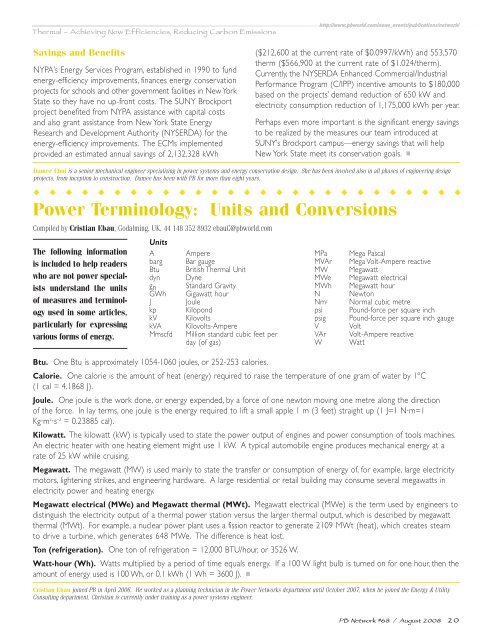Innovation in Global Power - Parsons Brinckerhoff
Innovation in Global Power - Parsons Brinckerhoff
Innovation in Global Power - Parsons Brinckerhoff
You also want an ePaper? Increase the reach of your titles
YUMPU automatically turns print PDFs into web optimized ePapers that Google loves.
Thermal – Achiev<strong>in</strong>g New Efficiencies, Reduc<strong>in</strong>g Carbon Emissions<br />
http://www.pbworld.com/news_events/publications/network/<br />
Sav<strong>in</strong>gs and Benefits<br />
NYPA’s Energy Services Program, established <strong>in</strong> 1990 to fund<br />
energy-efficiency improvements, f<strong>in</strong>ances energy conservation<br />
projects for schools and other government facilities <strong>in</strong> New York<br />
State so they have no up-front costs. The SUNY Brockport<br />
project benefited from NYPA assistance with capital costs<br />
and also grant assistance from New York State Energy<br />
Research and Development Authority (NYSERDA) for the<br />
energy-efficiency improvements. The ECMs implemented<br />
provided an estimated annual sav<strong>in</strong>gs of 2,132,328 kWh<br />
($212,600 at the current rate of $0.0997/kWh) and 553,570<br />
therm ($566,900 at the current rate of $1.024/therm).<br />
Currently, the NYSERDA Enhanced Commercial/Industrial<br />
Performance Program (C/IPP) <strong>in</strong>centive amounts to $180,000<br />
based on the projects’ demand reduction of 650 kW and<br />
electricity consumption reduction of 1,175,000 kWh per year.<br />
Perhaps even more important is the significant energy sav<strong>in</strong>gs<br />
to be realized by the measures our team <strong>in</strong>troduced at<br />
SUNY’s Brockport campus—energy sav<strong>in</strong>gs that will help<br />
New York State meet its conservation goals.<br />
<br />
Damee Choi is a senior mechanical eng<strong>in</strong>eer specializ<strong>in</strong>g <strong>in</strong> power systems and energy conservation design. She has been <strong>in</strong>volved also <strong>in</strong> all phases of eng<strong>in</strong>eer<strong>in</strong>g design<br />
projects, from <strong>in</strong>ception to construction. Damee has been with PB for more than eight years.<br />
<strong>Power</strong> Term<strong>in</strong>ology: Units and Conversions<br />
Compiled by Cristian Ebau, Godalm<strong>in</strong>g, UK, 44 148 352 8932 ebauC@pbworld.com<br />
The follow<strong>in</strong>g <strong>in</strong>formation<br />
is <strong>in</strong>cluded to help readers<br />
who are not power specialists<br />
understand the units<br />
of measures and term<strong>in</strong>ology<br />
used <strong>in</strong> some articles,<br />
particularly for express<strong>in</strong>g<br />
various forms of energy.<br />
Units<br />
A Ampere MPa Mega Pascal<br />
barg Bar gauge MVAr Mega Volt-Ampere reactive<br />
Btu British Thermal Unit MW Megawatt<br />
dyn Dyne MWe Megawatt electrical<br />
gn<br />
GWh<br />
Standard Gravity<br />
Gigawatt hour<br />
MWh<br />
N<br />
Megawatt hour<br />
Newton<br />
J Joule Nm 3 Normal cubic metre<br />
kp Kilopond psi Pound-force per square <strong>in</strong>ch<br />
kV Kilovolts psig Pound-force per square <strong>in</strong>ch gauge<br />
kVA Kilovolts-Ampere V Volt<br />
Mmscfd Million standard cubic feet per<br />
day (of gas)<br />
VAr<br />
W<br />
Volt-Ampere reactive<br />
Watt<br />
Btu. One Btu is approximately 1054-1060 joules, or 252-253 calories.<br />
Calorie. One calorie is the amount of heat (energy) required to raise the temperature of one gram of water by 1ºC<br />
(1 cal = 4.1868 J).<br />
Joule. One joule is the work done, or energy expended, by a force of one newton mov<strong>in</strong>g one metre along the direction<br />
of the force. In lay terms, one joule is the energy required to lift a small apple 1 m (3 feet) straight up (1 J=1 N·m=1<br />
Kg·m 2·s –2 = 0.23885 cal).<br />
Kilowatt. The kilowatt (kW) is typically used to state the power output of eng<strong>in</strong>es and power consumption of tools mach<strong>in</strong>es.<br />
An electric heater with one heat<strong>in</strong>g element might use 1 kW. A typical automobile eng<strong>in</strong>e produces mechanical energy at a<br />
rate of 25 kW while cruis<strong>in</strong>g.<br />
Megawatt. The megawatt (MW) is used ma<strong>in</strong>ly to state the transfer or consumption of energy of, for example, large electricity<br />
motors, lighten<strong>in</strong>g strikes, and eng<strong>in</strong>eer<strong>in</strong>g hardware. A large residential or retail build<strong>in</strong>g may consume several megawatts <strong>in</strong><br />
electricity power and heat<strong>in</strong>g energy.<br />
Megawatt electrical (MWe) and Megawatt thermal (MWt). Megawatt electrical (MWe) is the term used by eng<strong>in</strong>eers to<br />
dist<strong>in</strong>guish the electricity output of a thermal power station versus the larger thermal output, which is described by megawatt<br />
thermal (MWt). For example, a nuclear power plant uses a fission reactor to generate 2109 MWt (heat), which creates steam<br />
to drive a turb<strong>in</strong>e, which generates 648 MWe. The difference is heat lost.<br />
Ton (refrigeration). One ton of refrigeration = 12,000 BTU/hour, or 3526 W.<br />
Watt-hour (Wh). Watts multiplied by a period of time equals energy. If a 100 W light bulb is turned on for one hour, then the<br />
amount of energy used is 100 Wh, or 0.1 kWh (1 Wh = 3600 J).<br />
<br />
Cristian Ebau jo<strong>in</strong>ed PB <strong>in</strong> April 2006. He worked as a plann<strong>in</strong>g technician <strong>in</strong> the <strong>Power</strong> Networks department until October 2007, when he jo<strong>in</strong>ed the Energy & Utility<br />
Consult<strong>in</strong>g department. Christian is currently under tra<strong>in</strong><strong>in</strong>g as a power systems eng<strong>in</strong>eer.<br />
PB Network #68 / August 2008 20

















